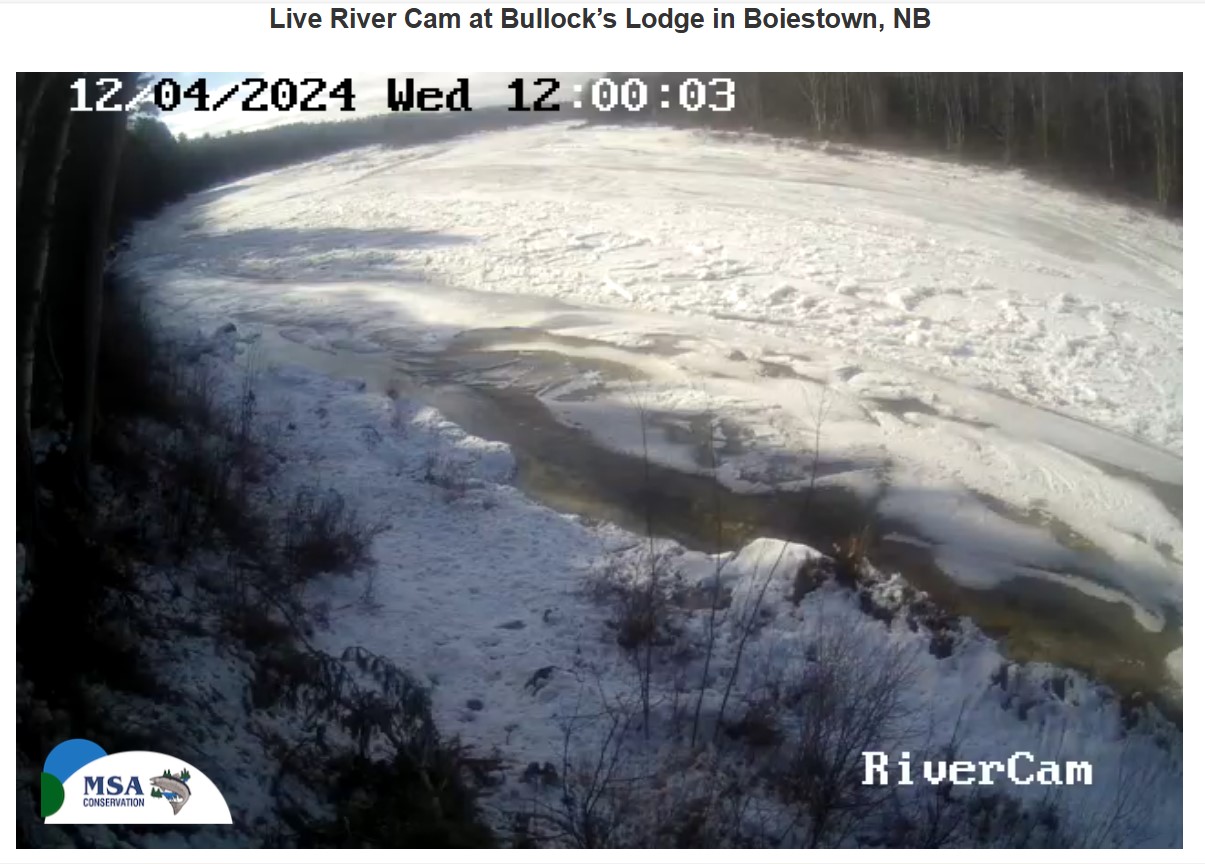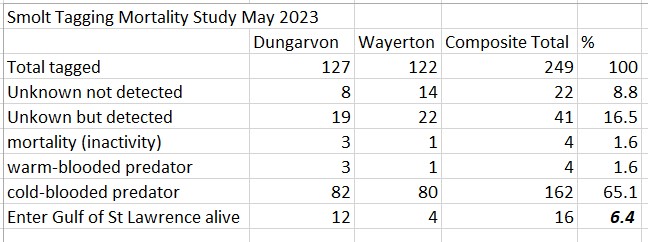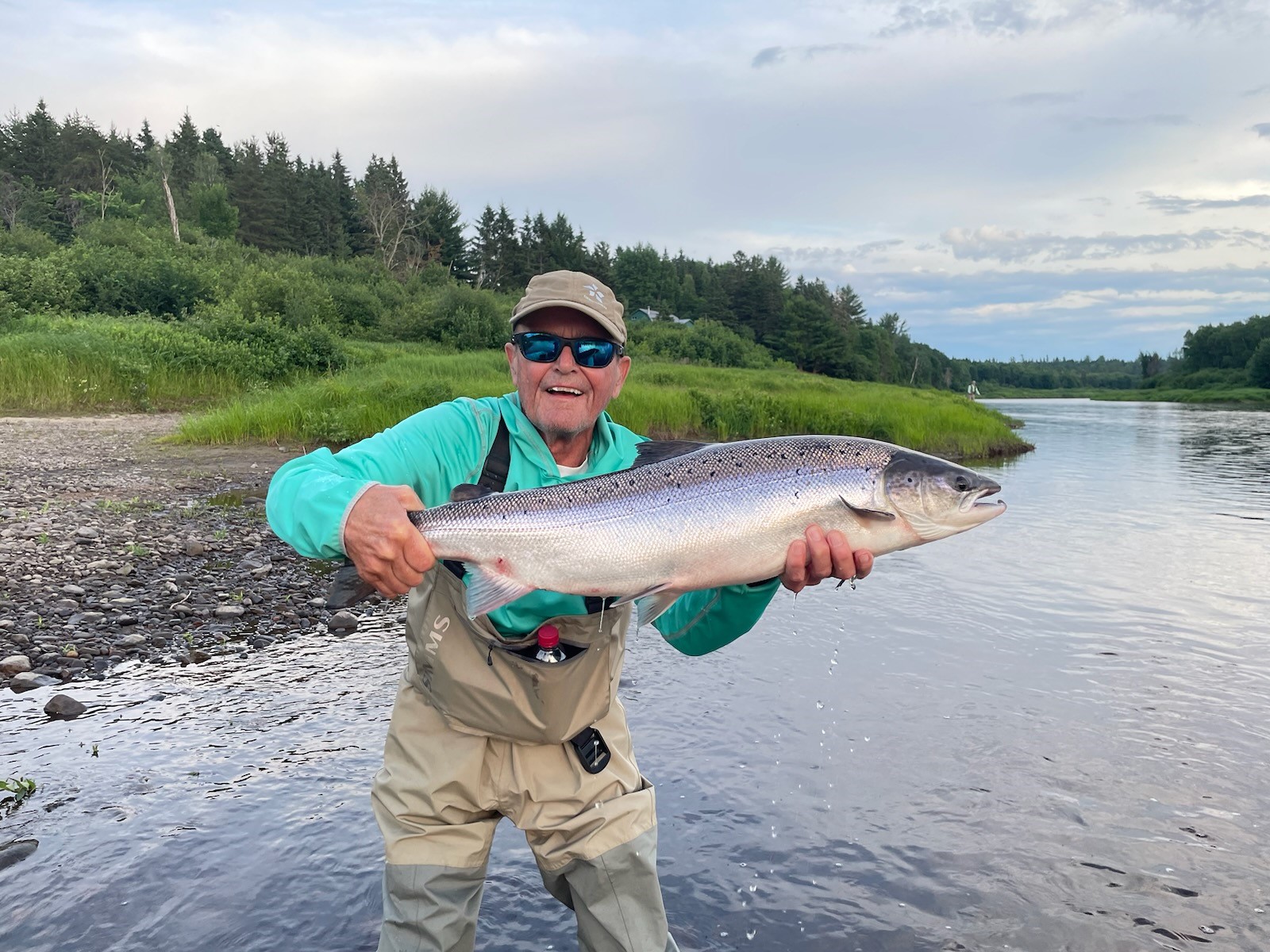
Getting Cold and Snowy on the Miramichi
Fishing Friends
While the early part of this fall was quite mild, the last couple of weeks have been substantially cooler. This week it has been freezing 24 hours a day with temperatures consistently below normal along the Miramichi Valley. As the photo below from Boiestown shows most of the river is already frozen. It was well into January before this pool froze last winter.
Twenty years ago, I remember feeling optimistic during the colder weather as I envisioned the salmon safely waiting under the ice for their chance to head back out to sea and become repeat spawners. I still like the thought of a good, cold winter along the Miramichi, but I have to admit that DFO’s stunning mismanagement of Atlantic salmon has soured things a bit for me. I don’t mean to sound like a broken record, but it is absolutely vital that we succeed in bringing DFO under enough pressure to take the necessary steps to turn the situation around. That is, that we must reduce the number of striped bass spawners to under 100,000, and we must stock the Miramichi system to start the salmon back on the recovery path. There is no way to take the remaining wild salmon away from natural spawning, so the clear path is to raise broodstock from wild smolts and where possible use the milt from precocious parr. There is a lot to be said for those approaches anyway, and the new MSA hatchery committee is working on a hatchery and stocking program plan to put in action well before next spring’s smolt gathering time.
I recently received some results from the smolt tagging program on the Miramichi undertaken during the spring of 2023. It is very sobering indeed. I pass this information on not to depress you but to motivate you to put the time, energy, and if you can do it, yes, even a little money into helping turn this situation around.
The graphic below shows the analysis of the radio tags attached to smolts gathered in the headwaters portions of these rivers and following them throughout their journey to the sea. The bottom line is that as recently as 2010 something around 70% of the smolts born in the headwaters areas of the river made it out to the Gulf of Saint Lawrence alive. Astoundingly, on both branches that number is now below 10% and on the NW Miramichi it is more like 3%.
The top line of the graphic above shows that 127 smolts were tagged in the Dungarvon and 122 in the NW Miramichi at Wayerton. Looking at the various categories of mortality we first come to unknown, not detected. That means that the tag disappeared but no signal could be found. An osprey could have picked up a smolt and flown off with it. Unknown but detected means the tag is probably lying on the bottom of the river possibly after passing through the digestive system of a predator. I don’t really understand the difference between that and inactivity, but it is an inconsequential number anyway. For those who wonder if warm blooded otters or seals are major predators, they may be for adult salmon, but they don’t appear to make a dent in the smolts. Cold blooded predators are believed to be almost entirely bass.
There is really very little differences on a percentage basis between the predation occurring on either river. The Dungarvon is not the Main Southwest Miramichi, but it is probably not a lot different either when it comes to smolt predation. Overall, 65% of the smolts are being gobbled up by the bass, and 28% are succumbing to all other sources of mortality combined. If you think that half of the 28% is actually striped bass – and it probably is at least that – then 79% of the smolts attempting to migrate out of the Miramichi are being eaten by striped bass. Compare this to the combined mortality from all sources of approximately 30% just 13 years previous – 2010 to 2023.
How serious is this 90% plus level of mortality? Well, clearly the more smolts that make it into the ocean the more that will come back. John Bagnall would say that the ocean is density independent. That means that if ocean mortality that year is 95% it doesn’t matter if there are 10 million smolts or one million going to sea. 5% of those numbers are all that will make it back. This is why it is critical to start with as many as possible.
So, what percentage of smolts must survive to reach the Gulf of Saint Lawrence for the Miramichi salmon population to be self-sustaining? Basically, you have to have enough spawning females coming back from the ocean to replace last year’s spawners, and you need some percentage more to make up for losses within the river prior to spawning. Bagnall has a developed an excel spreadsheet model that takes into account all of the variables. You start out with smolts making it to the ocean, then subtract ocean mortality, then estimate the returns of grilse and salmon both maiden and repeat spawners, then the expected egg deposition in the spawning gravel, then the survival of eggs to become fry, and fry to become smolts, and the whole process repeats.
Running Bagnall’s model, using all the most likely variable combinations, he comes up with the river being barely sustainable – really the breakeven point – when 40% of the outgoing smolts make it to sea. In 2010, when we had 70% there was a large surplus and we had strong runs. In good sea survival years the salmon population was growing. When only 6.4% survive to get out of the river, the salmon are being driven right over a cliff.
Does DFO know this? Of course they do. What do they have to say about it? Nothing. Why are they saying nothing? One can only speculate about that. Possibly they don’t care and consider the extirpation of Miramichi salmon to be a worth it to fill the Gulf of Saint Lawrence with striped bass is one very possible answer. That they do care, but don’t have the stomach for making the choices that will fix this problem is another possible answer. In some ways it really doesn’t matter which it is. It must be changed, and that is exactly what Save Miramichi Salmon’s approach through the courts is hoping to do.
I thought for this blog entry I would look back through the photos that appeared in my blog during 2024 and find one that reminded me of what I like about salmon fishing on the Miramichi. This photo was taken in late June at the Black Brook Salmon Club. The angler, Larry Persium, caught this beautifully conditioned early run salmon at the junction of the SW Miramichi and Cains Rivers. You’re looking right up the Cains over Larry’s left shoulder. I’ve seen days when I caught several like this in a session, but in general big, bright June salmon are never easy. Each and every one, though, is quite a prize. Even just watching one come up and boil at a fly is thrill enough to satisfy on many days. Also, beyond just the quality of the fish, take stock of the situation. This man was wading along a largely gentle, gravel shoreline, casting a small or moderate-sized fly on a purely floating line, and everywhere you look is beautiful, wild, quiet scenery. In salmon fishing you don’t have to be a young athlete, pounding your way offshore in a boat, or fishing in the middle of the night to catch fish like this one that is the equal of any that swims. You don’t know what you’ve got until its gone, and Miramichi salmon are too precious to take for granted.
Thanks for reading. Brad Burns
PS Don’t forget that this Friday at noon we start a two-week auction that is now up to 18 specially selected items. Check it out at this link Christmas Auction . This is all to support the conservation efforts of the Miramichi Salmon Assoc. If you haven’t bid in our auctions before, let me say that we have tried hard to make it easy. If you find that it’s not, please let me know how we can improve. In addition to the auction we have three raffles open. These are a Sage rod, Sage reel, Rio fly line. These have been very popular every year because the winner gets to pick exactly the rod, reel or fly line that they want. Check it out!
And oh yes, PS number 2! Don’t forget the MSA US event on Feb. 22. Not only are we honoring both John Swan and Luther Hall, but Maine’s own Bill Green, host of Bill Green’s Maine, is going to attend and be the auctioneer. It will be an evening to remember, and hopefully a great one for the salmon. More info and tickets available now at this link on the MSA;s website.





The food supply for the striped bass is rapidly diminishing. The number of rainbow smelt, Gaspereau, and smolts has reached an all time low. It is reasonable to anticipate that the number of striped bass will follow this trend.
Perhaps the DFO and town officials who pride themselves in the crowds at their local striped bass tournaments will soon realize that no member of an ecosystem can survive independently
Great comment Marty. It isn’t even just the river. The ridiculously inflated bass numbers must be taking a big toll on things likes flounders and lobsters within the Bay too.